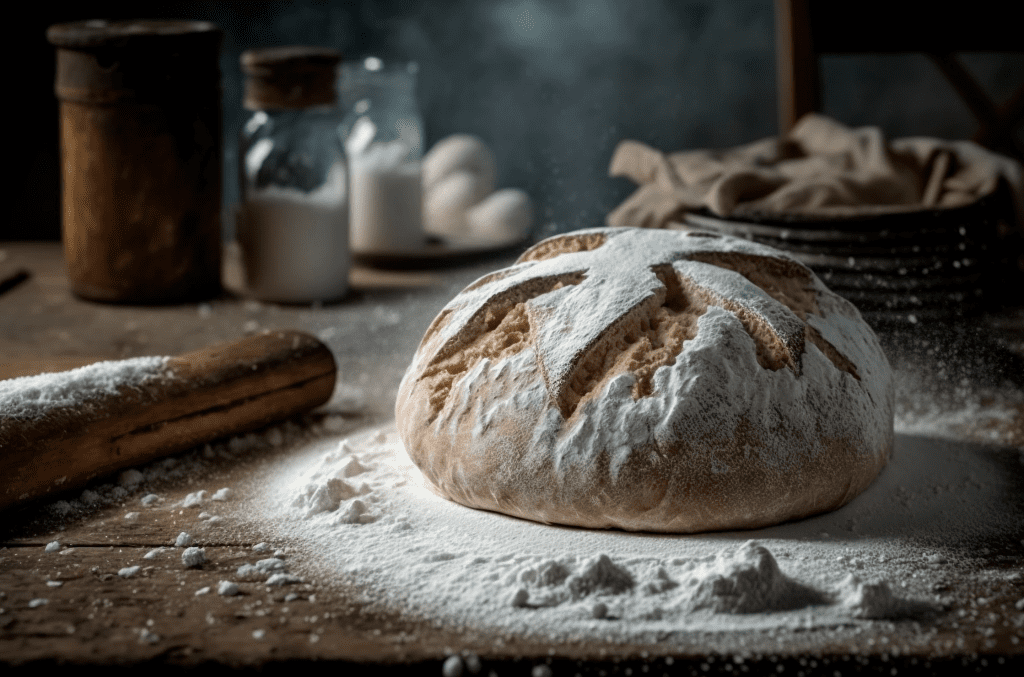Sourdough baking can be a deeply rewarding process, but it can also present a number of challenges. Here are some common problems and how to troubleshoot them:
Starter: Insufficient rise and lack of bubbling in the starter may occur if it’s not fed regularly enough or the room temperature is too cold. To address this, ensure you feed your starter daily when kept at room temperature or weekly if refrigerated. Additionally, placing the starter in a warmer environment can help expedite its activity.
Dough during Bulk Fermentation: If the dough fails to rise adequately during bulk fermentation, it could indicate that the starter wasn’t sufficiently active when incorporated. It’s crucial to ensure that your starter reaches its peak activity before using it. Moreover, in colder kitchen environments, the dough may require more time to rise properly.
Dense Loaf: A dense loaf is often the result of under-proofing, where the dough doesn’t have sufficient time to rise before being baked. However, it could also be caused by a lack of proper hydration in the dough. To address this, it’s important to give the dough ample time to rise and ensure that you’re adequately hydrating it.
Flat Loaf: If your loaf spreads out and becomes flat during baking, it’s likely due to over-proofing. When the dough rises excessively before being baked, it can collapse and lose its structure. This issue may also indicate that the dough lacks strength. To rectify this, incorporating more kneading or folds during bulk fermentation can help strengthen the dough.
Excessively Sour Sourdough: If your sourdough bread turns out overly sour, it’s possible that your starter has become overly acidic. Regular feedings can help restore the balance of acidity in the starter. Additionally, if you find that the bread becomes increasingly sour the longer you ferment the dough, it might be necessary to reduce the fermentation time to achieve the desired level of sourness.
Thick or Hard Crust: If your bread develops a thick or hard crust, it can be a result of either an oven that is too hot or the bread being baked for an extended period. To address this, you can try reducing the oven temperature or adjusting the baking time. Another helpful technique is to bake the bread in a dutch oven or other covered dish, as it can create steam and prevent the crust from becoming excessively hard.
Gummy Crumb: When the crumb of your bread turns out gummy or moist, it’s often due to under-baking or slicing the bread too soon. To remedy this, ensure that the internal temperature of the bread reaches around 205-210°F (96-99°C) before removing it from the oven. It’s crucial to allow the loaf to cool completely before slicing to prevent the moisture from being trapped inside.
Inactive Sourdough Starter: A healthy and active sourdough starter is vital for successful sourdough bread. If your starter isn’t bubbling or rising, it’s likely because it’s not being fed regularly enough or the environment is too cold. Establishing a consistent feeding regimen is crucial to maintain the yeast and bacteria’s activity in the starter. For room temperature storage, daily feeding is recommended, while weekly feeding is sufficient if stored in the refrigerator. The ideal temperature range for a sourdough starter is around 70-75°F (21-24°C). In colder environments, finding a warmer spot for your starter or using warmer water during feeding can help maintain its activity.
Poor Oven Spring: Oven spring refers to the final burst of rising or “spring” that occurs in the oven due to the heat. If your bread doesn’t achieve a good oven spring, it could be a result of over-proofed dough, insufficient oven temperature, or inadequate steam in the oven. To improve oven spring, it’s essential to preheat your oven sufficiently. Using a baking stone or dutch oven can help retain heat and promote better rising. Additionally, creating steam in the oven, either by using a water pan or spraying water, can help prevent the crust from forming too quickly, allowing the bread to rise more effectively during baking.
Dough is Too Sticky: While it is normal for sourdough dough to be slightly stickier compared to dough made with commercial yeast, excessive stickiness can indicate either overhydration or insufficient gluten development. To address this, you can consider reducing the amount of water in the dough or increasing the flour quantity. Moreover, improving gluten development through longer or more intense kneading, or incorporating a series of folds during bulk fermentation, can enhance the structure of the dough, making it easier to handle.
Crust is Too Dark: If your bread consistently comes out with a dark crust, it may be due to your oven temperature being too high or the bread being baked for an extended duration. To rectify this, try reducing the oven temperature or adjusting the baking time. If only the top of the bread is getting too dark, you can cover it with aluminum foil partway through baking to prevent further browning.
Bread is Not Sour Enough: The level of sourness in sourdough can vary based on multiple factors. If you find that your bread isn’t sour enough to your liking, there are a few techniques you can try. One approach is to ferment the dough for a longer period at a cooler temperature, as this can enhance the development of sour flavors. Additionally, maintaining your starter on a rye or whole grain diet can encourage the growth of more acidic bacteria, resulting in a tangier taste.
Crust is Too Thin or Soft: If your crust consistently turns out too thin or soft, it might be an indication that your oven is not reaching a high enough temperature or that there is excessive steam during baking. Consider increasing the oven temperature to achieve a crisper crust. If you’re using a method to create steam, such as a water pan, you can try removing the steam partway through the baking process to allow the crust to harden.
Sourdough Bread Tastes Too Yeasty: If your sourdough bread has an overly yeasty or beer-like taste, it could be due to overfeeding your starter or fermenting the dough for too long. While it’s important to maintain regular feedings for your starter, overfeeding can lead to an overgrowth of yeast, resulting in a strong yeasty flavor. Similarly, fermenting the dough for an excessive duration can also contribute to a pronounced yeast flavor. Adjusting the feeding frequency and fermentation time can help achieve a more balanced and desired taste.
Remember, sourdough baking is as much an art as it is a science. It may take some time to get familiar with your starter and your environment. Patience and practice will go a long way in mastering this craft.





















